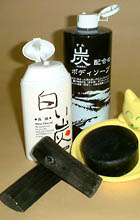NATURAL, HEALTHY, AND CHEAP:
Taking a Fresh Look at Charcoal
November 9, 1999
 |
|
Charcoal is returning to people's daily lives in a variety of forms.
|
|
Charcoal is often considered to be a fuel of the past in Japan. Modernization has made this material a less common part of people's lives as they have turned to newer options for cooking and heating. But now charcoal is once again coming into the limelight as a substance that is friendly to both the environment and the human body.
All-Good Stuff
Charcoal is made by steaming and refining wood at very high temperatures. It has been used for ages to heat homes, but from around the 1960s other agents, such as electricity, kerosene, and gas, took its place. In recent years the use of charcoal has mostly been limited to cooking fish and meat, whose flavor is improved by the far-infrared rays coming from charcoal flames. Even today, there are a good number of restaurants that draw customers with charcoal-grilled dishes.
New trends are emerging, however, making use of the cleansing, deodorizing, and dehumidifying effects of charcoal. Charcoal is a very porous material with the ability to adsorb moisture and chemical substances. It can thus be used, for example, as a deodorant for refrigerators and as a dehumidifier for closets. In addition, charcoal is rich in such minerals as calcium and potassium. Cooking rice with a chunk of charcoal in the pot improves the taste, and one can easily make mineral water by putting charcoal in tap water. Charcoal is readily available in the camping sections of department and variety stores as well as in fuel stores. And even the deluxe charcoal known as bincho-tan is quite affordable: The price for one kilogram (2.2 pounds) is about 1,500 yen (14.30 U.S. dollars at 105 yen to the dollar).
New Uses, New Products
Businesses have jumped at the opportunity and are coming out with new products using the merits of charcoal. These include self-dehumidifying pillows with stuffing made of powdered charcoal blended into polyethylene resin; woven underfloor mats that use charcoal and obsidian, a powerful deodorant and an effective humidity controller, to keep away mold and termites; body soaps that prevent body odor; and shampoos and facial cleansers that use charcoal's adsorptivity to soak up impurities.
Another popular product is "wood vinegar," which is made by cooling and liquidizing the smoke produced when charcoal is made. Rich in hydrocarbons and lignin, this liquid is a good remedy for athlete's foot and other skin irritations due to its ability to improve the skin's regenerative power and to warm the body. It is therefore used in such products as bath essences and foot lotions.
Pumping Life Back into Towns with Charcoal
Many local governments are taking up charcoal production as a means of revitalizing their communities. Plants are being built across Japan to produce charcoal out of waste wood that results from tearing down houses and pruning trees. Charcoal making is expected to become an important industry for these towns.
In the town of Shitara in Aichi Prefecture a charcoal &"school" was opened in late September 1999; participants live in the area for six months while they receive training from local elders in the skill of charcoal making. On Togo, an island in the Japan Sea off the coast of Shimane Prefecture, wood vinegar is sold to local farms as a substitute for pesticides. Fukui Prefecture is planning to set up a liaison council for charcoal producers by the end of 1999 and aims to expand demand for charcoal-related goods by developing new products. Tokushima Prefecture subsidizes activities for promoting the charcoal industry and also advertises and sells charcoal products at various functions.
Charcoal consumption in Japan reached its peak in the 1950s and 1960s; today there are very few people who support themselves on charcoal making. Charcoal is now attracting renewed interest, however, as a product that is not only cheap and handy, but is made by recycling otherwise useless material and has no detrimental effects to health. Nowadays one hardly ever sees threads of smoke arising from charcoal-making huts in the mountains of Japan. If industrial and regional interests merge to pave a firm future for the charcoal market, though, this may once again become a common sight.
 Edited by Japan Echo Inc. based on domestic Japanese news sources. Articles presented here are offered for reference purposes and do not necessarily represent the policy or views of the Japanese Government.
| 



















